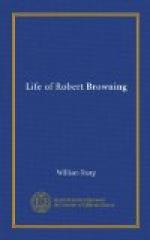A little earlier she had even, unwittingly on either side, been a collaborateur with “the author of ‘Paracelsus.’” She gave Horne much aid in the preparation of his “New Spirit of the Age,” and he has himself told us “that the mottoes, which are singularly happy and appropriate, were for the most part supplied by Miss Barrett and Robert Browning, then unknown to each other.” One thing and another drew them nearer and nearer. Now it was a poem, now a novel expression, now a rare sympathy.
An intermittent correspondence ensued, and both poets became anxious to know each other. “We artists—how well praise agrees with us,” as Balzac says.
A few months later, in 1846, they came to know one another personally. The story of their first meeting, which has received a wide acceptance, is apocryphal. The meeting was brought about by Kenyon. This common friend had been a schoolfellow of Browning’s father, and so it was natural that he took a more than ordinary interest in the brilliant young poet, perhaps all the more so that the reluctant tide of popularity which had promised to set in with such unparalleled sweep and weight had since experienced a steady ebb.
And so the fates brought these two together. The younger was already far the stronger, but he had an unbounded admiration for Miss Barrett. To her, he was even then the chief living poet. She perceived his ultimate greatness; as early as 1845 had “a full faith in him as poet and prophet.”
As Browning admitted to a friend, the love between them was almost instantaneous, a thing of the eyes, mind, and heart—each striving for supremacy, till all were gratified equally in a common joy. They had one bond of sterling union: passion for the art to which both had devoted their lives.
To those who love love for love’s sake, who se passionnent pour la passion, as Prosper Merimee says, there could scarce be a more sacred spot in London than that fiftieth house in unattractive Wimpole Street, where these two poets first met each other; and where, in the darkened room, “Love quivered, an invisible flame.” Elizabeth Barrett was indeed, in her own words, “as sweet as Spring, as Ocean deep.” She, too, was always, as she wrote of Harriet Martineau, in a hopeless anguish of body and serene triumph of spirit. As George Sand says, of one of her fictitious personages, she was an “artist to the backbone; that is, one who feels life with frightful intensity.” To this too keen intensity of feeling must be attributed something of that longing for repose, that deep craving for rest from what is too exciting from within, which made her affirm the exquisite appeal to her of such Biblical passages as “The Lord of peace Himself give you peace,” and “He giveth His Beloved Sleep,” which, as she says in one of her numerous letters to Miss Mitford, “strike upon the disquieted earth with such a foreignness of heavenly music.”




